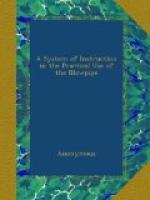(6) in mic. salt. As in
borax, but leaves an insoluble siliceous
skeleton.
(7) with carb. soda. With
a small quantity of the alkali fuses to a
black bead. With a larger
quantity forms a slag.
(8) Special reactions. —
* * * * *
Mineral. Diallogite
Formula. [.Mn][..C].
Behavior
(1) in glass-bulb. Frequently
decrepitates and gives off more or
less water.
(2) in open tube. —
(3) on charcoal. If strongly
heated and moistened has an alkaline
reaction
on litmus paper due to the presence of
Ca.
(4) in forceps. V. Frequently colors the flame slightly red.
(5) in borax. Gives the manganese and iron reactions.
(6) in mic. salt. As in borax.
(7) with carb. soda. Forms an infusible slag.
(8) Special reactions. In warm acid dissolves with much effervescence.
* * * * *
Mineral. Triplite
Formula. ([..Mn][.Fe])^{4}[.....P].
Behavior
(1) in glass-bulb. Generally
gives off more or less
water.
(2) in open tube. —
(3) on charcoal. —
(4) in forceps. I. Colors the outer blowpipe flame green ([.....P]).
(5) in borax. Gives the manganese and iron reactions.
(6) in mic. salt. As in borax.
(7) with carb. soda. Forms an infusible mass.
(8) Special reactions. —
* * * * *
NICKEL AND COBALT.
* * * * *
Mineral. Millerite
Formula. NiS.
Behavior
(1) in glass-bulb. —
(2) in open tube. Evolves SO^{2}.
(3) on charcoal. Fuses with much ebullition to a magnetic bead.
(4) in forceps. —
(5) in borax. The roasted
mineral gives a nickel reaction,
slightly
modified by small quantities of iron
and
copper.
(6) in mic. salt. As in borax.
(7) with carb. soda. Fuses to a
slaggy mass, which on silver gives
the
sulphur reaction.
(8) Special reactions. —
* * * * *
Mineral. Coppernickel
Formula. Ni^{2}As.
Behavior
(1) in glass-bulb. Gives off a little AsO^{3}.
(2) in open tube. Gives off
much AsO^{3} and some SO^{2} and falls
to
powder.




